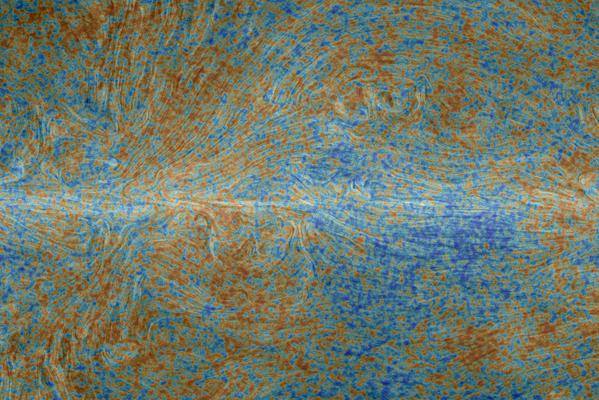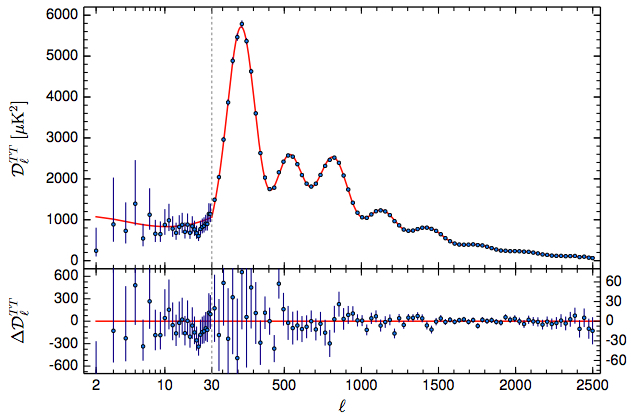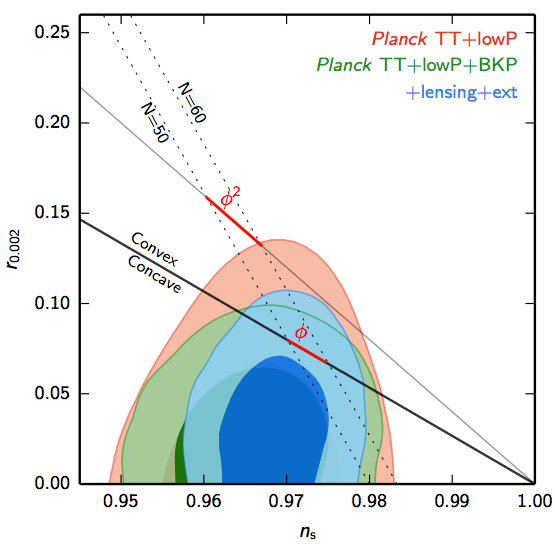Well hello, blog. It’s been too long! Feels good to be back.
The big cosmological excitement this week was the announcement of new cosmic microwave background measurements. These include a big release of new papers from the Planck satellite, as well as a joint polarization analysis combining data from BICEP2, the Keck array, and Planck.

The good news is: we understand the current universe pretty darn well! So much so, in fact, that even an amazingly high-precision instrument such as Planck has a hard time discovering truly new and surprising things about cosmology. Hence, the Planck press releases chose to highlight the finding that the earliest stars formed about 0.1 billion years later than had previously been thought. Which is an awesome piece of science, but doesn’t quite rise to the level of excitement that other possible discoveries might have reached.

For example, the possibility that we had seen primordial gravitational waves from inflation, as the original announcement of the BICEP2 results suggested back in March. If you’ll remember, the polarization of the CMB can be mathematically decomposed into “E-modes,” which look like gradients and arise naturally from the perturbations in density that we all know and love, and “B-modes,” which look like curls and are not produced (in substantial amounts) from density perturbations. They could be produced by gravitational waves, which in turn could be generated during cosmic inflation — so finding them is a very big deal, indeed.
A big deal that apparently hasn’t happened. As has been suspected for a while now, while BICEP2 did detect B-modes, they seem to have been generated by dust in our galaxy, rather than by gravitational waves during inflation. That is the pretty definitive conclusion from the new Planck/BICEP2/Keck joint analysis.
And therefore, what we had hoped was a detection of primordial gravitational waves now turns into a less-thrilling (but equally scientifically crucial) upper limit. Here’s one way of looking at the situation now. On the horizontal axis we have ns, the “tilt” in the power spectrum of perturbations, i.e. the variation in the amplitude of those perturbations on different distances across space. And on the vertical axis we have r, the ratio of the gravitational waves to the ordinary density perturbations. The original BICEP2 interpretation was that we had discovered r = 0.2; now we see that r is less than 0.15, probably less than 0.10, depending on which pieces of information you combine to get your constraint. No sign that it’s anything other than zero.

So what have we learned? Here are some take-away messages.
- BICEP2 was an amazingly successful experiment, performed by some incredibly talented and dedicated scientists. They measured B-modes in the sky at an unprecedented level of precision! Nothing in the new results overturns this.
- What they got wrong was the interpretation. Even there, the original paper they submitted is mostly careful, focusing on the detection and putting the inflationary stuff at the end. And in the revised version they were very conservative indeed. In retrospect they were too stingy in imagining how much contamination there could be from dust, which is certainly a hard problem. For good reasons, they intentionally looked at a part of the sky where there is very little dust, and they incorrectly extrapolated known measurements down to this unknown territory. Which is still, really, not such a big deal; everyone makes mistakes, and in this case the existing data and state of the art were just not that clear.
- More problematic was the public announcement of the results. The team placed a heavy emphasis on the inflationary interpretation, even inviting Alan Guth and Andrei Linde to the press conference. In retrospect, this was a misjudgment. If their B-modes really were evidence for inflation, that would have become established over time, and they would have gotten all the credit. The gold standard of scientific caution comes from CMB pioneers Arno Penzias and Robert Wilson, who after discovering the CMB itself wrote a paper titled simply “A Measurement of Excess Antenna Temperature at 4080 Mc/s.” We should all aspire to being so careful! But most of us mere human beings will occasionally get excited, especially when we potentially discovered something new and amazing about the universe.
- We’re still looking for those primordial B-modes! The hope is to improve limits (or detections…) to at least r ~ 0.01, and potentially r ~ 0.001, over the next few years. Stay tuned.
- Even if we do find inflationary B-modes, it doesn’t look like Planck will be the one doing so, since they have almost reached their limit. So I think it’s safe to say that I’ve won my bet with Max Tegmark. (And lost a post-BICEP2 bet with Neal Weiner. Which was, quite intentionally, smaller.)
- Inflation is not ruled out! The BICEP2 figure of r = 0.2 was really at the absolute upper reach of what anyone was predicting from realistic inflationary models. There is plenty of room for inflation to still be right, but the value of r to be so small that we haven’t yet seen it.
- But we don’t know whether inflation is correct! The strongest predictions of inflation — spatial flatness, scale-free primordial density perturbations — have an annoyingly generic quality. You might expect them to arise in some non-inflationary scenario for the very early universe, even if we don’t have many good candidates for what such a scenario might be. The small tilt of the spectrum (characterized by the fact that ns in the figure above is less than, rather than equal to, one) is a nice feature that you would expect in inflation, so that adds a bit of support. But the gravitational waves would have been very strong support. In their absence, I think there’s still lots of room for clever people to come up with good alternatives to inflation. As I said on Twitter:
When the data retreat, theory moves boldly forward! Time to step up, early-universe theorists.
— Sean Carroll (@seanmcarroll) January 30, 2015
- Further in that direction, keep in mind how little we truly understand about the extremely early universe. Had BICEP2’s B-modes actually been primordial, it would have represented a fantastic leap in the energy scales to which we have observational access. The converse is just as important: in the absence of empirical data, we should be extremely cautious in extrapolating our current knowledge (or projecting our favorite theories) into realms that are so far away from the part of the world we’ve actually looked at.
At the end of the day: good science, slight bobble with the publicity, corrected before too long by good science again. I’m certainly disappointed that we haven’t yet obtained any direct empirical information about the first trillionth of a trillionth of a trillionth of a second after the Big Bang, but I’m willing to hang in there and see what the next round of experiments (and theories) will bring.
BICEPT2 results are still very strong. B polarization by gravity waves is 92% probable and dust 8%. This is not conclusive, but it is still worth our further research.
Here is my “layman” understanding of the situation. BICEP2 underestimated the contribution from dust and therefore concluded that the B-mode polarization observed was due to inflation. Planck results gave a much better estimate of the contribution due to dust and when those are taken into account we can’t conclude that the B-mode polarization is due to inflation. I also read somewhere that Planck data set is the most up to date measurement of galactic dust. So based on these measurements are there any patches of the sky that we should be looking at where the dust would be really low so that we have a better chance of getting good data? Are any experiments already doing this?
Just ordered your Teaching Company course on Higgs and beyond. Know it will be as great as your other courses with them.
Maybe adS/CFT will come through after all by studying Quantum Chromodyamics? QGP and axion testing and a deeper look into the super-fluid natures?
I agree. This should be a good lesson to the entire community that we should never get too excited to keep the scientific objectivity. Scientific discoveries, no matter how significant it is, can only be advised to public after have been strictly reviewed and considered as firmly established in the experts.
In the CMB power spectrum there is a pretty evident dip around l=20 that the theoretical fit does not describe. Does anyone know what that might be due to?
As the value of r gets refined, are there thresholds where some inflation models would be eliminated?
YES! Down with gravitational waves! Although, I think I would have been happier if it was for the reason I thought it was for them being in error (not really sure about these new “phototronics”). I will try to see that no one or nothing (not even gravitational waves) changes the speed of light in my theoretical universe (except maybe cosmic expansion and quantum entanglement, darn it)!
That first graphic is really beautiful. Would love a framed hi res image of that on my wall!
The title of the Penzias and Wilson letter reflects less caution than the fact they were clueless as to what the radiation was. The preceding letter by Dicke et al speculated correctly that it was the CMB.
An alternative to inflation would be a universe (space-time) that started out flat and aging fast. A rapid aging epoch would expand fast under the influence of Dark Energy. As the radius of the universe increased time dilation to over and the universe began to age and expand slowly. A paper that provides the foundations of such a scenario can be found here http://www.worldscientific.com/doi/abs/10.1142/S0219887815500425
Sean,
Please start filtering out these comments. Some of these comments are crap. Especially Stuart’s. At the very least, turn on the voting feature.
Pingback: ΛCDM – und sonst nix: das Vermächtnis von Planck | Skyweek Zwei Punkt Null
@Mike Stop telling Sean what to do. I see no offense in Stuart’s comment. Your attitude may be best described as trolling.
@ Neil
The title of the Penzias and Wilson letter reflects less caution than the fact they were clueless as to what the radiation was.
Not true. The very first paragraph of the Penzias and Wilson paper includes this sentence:
“A possible explanation for the observed excess noise temperature is the one given by Dicke, Peebles, Roll, and Wilkinson (1965) in a companion letter in this issue.”
Hello, Sean, I am not your blog and do not intend to control your blog. I invent you to see mine, however, (most of them are trash talk, however, funny) http://weibo.com/u/5384670001/home
My admission seems to be related to gravitational waves. But I can gave up and do something else if it is too hard. I am not a kid.
I think the BICEP2 team was too happy, if I were them, I would be more conservative.
@Bavaruspex: In the amazingly theory-conforming power spectrum there are quite a few l-values, not only around l=20, where the fit is imperfect and the error bars don’t get to touch the theoretical curves. I like these places most, because from them might arise unsuspected and exciting new theoretical twists. Certainly, the fact they are few, and overwhelmed by the great picture of agreement, should not make physicists sweep them under the rug. How dull would physics be today if late-19th century physicists had swept some annoying discrepancies under their 19th century-style rugs.
Pingback: La storia dell’Universo secondo Planck | AstronomicaMens
have you seen this yet, and what do you think of it?
Cosmology from quantum potential
Ahmed Farag Ali, Saurya Das
10.1016/j.physletb.2014.12.057
arXiv:1404.3093 [gr-qc]
Is Higgs inflation now more favoured? Compare the predictions of Bezrukov and Shaposhnikov in 2008 (arXiv:0710.3755v2) with your diagram and it seems spot on! Or is this theory too far from conventional?
Pingback: BICEP-2 Maybe Not Sigma-5 Eh?
Pingback: The State of the Early Universe – in italiano anche : l’errore di BICEP2 è ufficiale | controappuntoblog.org
@Gaehazzi
All true and I think it is important to look at these places. But one thing to keep in mind is that as the multipole number gets smaller, the number of data points gets small and so the possibility that the value we see is just a fluke is increased. This is not encoded in the error bars — those bars are in part affected by the small number of data points, but the bar reflects the confidence that e.g. the actual dipole moment that we see in our sky is in the range on the graph. What I’m saying is that if we could sample the dipole moment from other locations where the CMBR would be unrelated to ours (distances equal to the length of recombination, so 50,000-ish light years?), we might measure a different dipole moment and the average of them might be right on the theoretical line.
Again, not saying there’s nothing possibly of interest there to explain, but the farther left on the graph you go, the harder it is to know if there is really anything that needs to be explained at all beyond “selection bias”.
I would love to contribute to this blog since I somehow knew the BICEP 2 experiment would be obscured by dust. However, the ambiguity of my external corporate social media policy prevents me from commenting and doing so may risk my livelihood and employment.
Do anybody know why 50-60 e-foldings always used as the reference in the exclusion plots? Is there a historical reason for this or is there a real problem with too many e-folds?